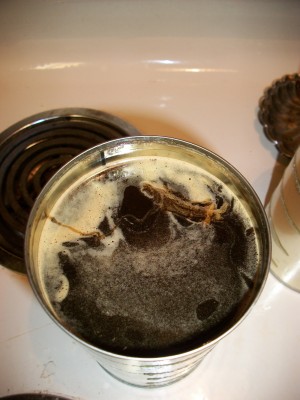 Craft beer is seeing a surge of professional brewers that are selling beers in aluminum cans, which is a good thing. However, when it comes to homebrewing cans can be a bad thing!
Craft beer is seeing a surge of professional brewers that are selling beers in aluminum cans, which is a good thing. However, when it comes to homebrewing cans can be a bad thing!
I remember my first couple of homebrew recipe kits. They both came with canned malt. They were easy to use, just popping off the lids, ripping off the labels and warm them up in a pan of hot water. When it was time to add them to the boiling water, I just poured them in, like an awesome syrup that was going to turn into beer.
A lot of beginner recipe kits come with cans filled with liquid malt extract. They seem like a good idea, they’re easy to store and since they’re cans it seems like the malt should be pretty stable inside of them. Since they’re in cans, they’re not going to be extremely fresh, but how bad could they be?
Pretty bad in some cases! They’re often sitting on the shelves for months, sometimes years and even though they’re in cans, they can dramatically change. A light malt can end up dark, changing the end product that you’re going to be drinking.
The problem with those cans of malt is that almost no one knows how long they were sitting on the counter before you brought them home. I suggest sticking with the liquid malt extract that’s in the milk looking jug. If there isn’t an expiration date, and even if there is, ask your homebrew shop how old it is. A lot of the time they can answer that and even point you towards the fresher malt extract.
Of course, there is another solution. You can go all grain and make your own malt, but for now we’ll save that for the more advanced homebrewers.
—
Stay up to date with Passion For The Pint via Facebook, Twitter or subscribing to thenewsletter (and free homebrew ecourse).
This advice is somewhat questionable. A lot of liquid malt extract manufacturers do put dates on their canisters. In fact, all it might take is knowing how to read the info. Briess, for example, puts a six digit label on their cans that reads yymmdd which would be 120101 for January 01, 2012. Buying in a jug is not necessarily better because once you open the container you are risking wild critters getting in there. It’s fine if you’re using it rather soon, but if you don’t know when that next batch is coming you don’t necessarily fare well with that approach unless you can afford space in the fridge for a big jug. Those bubbles in the extract in the picture above are just from the can being shifted around. 3.3# cans are perfectly suitable for the casual home brewer as long as you’re buying from a reputable retailer that pays attention to product freshness.
I think that’s the key point. There’s a lot of reputable retailers, but there’s also some that look for profits more than the quality of the product.
Those folks are pretty easy to spot primarily by how they keep their store up and how they treat customers.